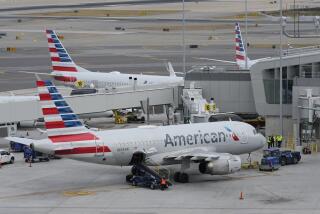Executive Travel : Getting Airline Miles on the Ground
- Share via
It used to be the only way to earn a frequent-flier freebie ticket was to be a frequent flier.
But that’s no longer the case. With the mushrooming growth of mileage promotions, it’s now possible to earn a free ticket without taking a single trip.
The number and diversity of such programs is skyrocketing, said Randy Petersen, publisher of Colorado-based InsideFlyer magazine.
One part of the growth is aimed directly at consumers. The airlines have figured out they can use other retailers to sell seats for them, he said. Carriers such as American, United, Continental, Northwest and Delta sell blocks of miles in the form of frequent-flier certificates to retailers, often at 2 cents a mile. Retailers and other companies then use them as incentives to build repeat business.
A Miami hair salon, for example, will award 500 miles for customers who buy $500 worth of services. Dial-a-Mattress in New York awards miles for bed purchases--the bigger the bed, the more mileage you get. Indeed, consumers can earn miles buying everything from security systems to tires, Petersen says.
In addition, there are already more than 2,700 incentive programs that give miles as awards to employees for performance or sales, and industry observers expect the number to hit 5,000 in the next 18 months.
“It’s growing like crazy, and it’s going to continue to grow as more and more people see mileage as a type of currency,” said Harris Turner, who runs the Indianapolis-based Frequent Flyer Marketing Assn., a trade group for people who run frequent-flier programs. Turner is also the publisher of the “Flyer’s Edge,” a general reference on mileage programs.
To help organize this information, “Flyer’s Edge” plans to launch a Web site on the Internet later this month that will allow travelers to check mileage for different programs on line.
Next year Petersen plans to publish “The Miles Guide,” a quarterly directory categorizing companies that give away miles and the conditions for getting them.
The directory will be organized by type of product, by airline program, and by state, Petersen said. If a person knows he needs to buy tires, he can look up tires to see which companies offer mileage tie-ins. Alternatively, if a person needs a few more miles to make an award limit, she can look under her airline and her state to see which companies might have products she’s interested in buying.
But despite all the new options, mileage collectors need to make sure a reward program is worth their time and trouble.
Receiving miles for regular expenses--such as credit cards purchases, long-distance phone calls or restaurant meals--is popular because such programs have been set up to be almost automatic for the consumer and over time provide a significant number of miles.
Before you get carried away with this new form of currency, keep some things in mind:
The reward is only a good deal if you would buy the product anyway. In essence, consumers are prepaying for a ticket through their purchases of other items, Petersen says. Buying things you don’t need just to get miles isn’t going to save you anything.
The so-called “affinity” credit cards can be a boon--or can encourage debt. If the cards carry steep interest rates and annual fees, the mileage may not be worth it--especially if you won’t use the cards much or if you carry a large balance from month to month.
Figuring the value of the miles at 2 cents each, with a card you pay $50 a year to use, you would have to charge $2,500 worth of goods and receive one mile per dollar charged just to break even. (The two-cent figure is only an approximation. Mileage could be worth more or less depending on your travel habits and other factors.)
If you pay high interest rates to borrow for purchases you do not need to make, the cards are helping to make you financially irresponsible. Miles can’t make up for 18% annual rates. But the cards make a lot of sense for people who charge a lot anyway and who pay the cards off each month.
Expect new twists as the programs proliferate, but be wary. American Airlines recently announced that it will create a program with certain banks that rewards a mile for each dollar of interest paid on a mortgage loan. The November issue of Consumer Reports Travel Letter points out that paying even a tiny premium on the interest rate for a mortgage could easily wipe out the value of mileage earned this way.
For example, the newsletter cites a $200,000 fixed-rate mortgage with a rate of 7.5% for 15 years. A consumer would pay about $134,000--and earn 134,000 miles--paying off that mortgage. Valued at 2 cents a mile, that translates into a mileage credit worth $2,680. But if the mortgage rate was half a point higher, the interest cost would be $9,000 higher. Tax considerations might make an eighth of a point worth paying, but there are other factors too. After all, 15 years is a long time, and if the mileage program ended after five years, you might be stuck with a higher interest rate and no miles.
More to Read
Sign up for The Wild
We’ll help you find the best places to hike, bike and run, as well as the perfect silent spots for meditation and yoga.
You may occasionally receive promotional content from the Los Angeles Times.






